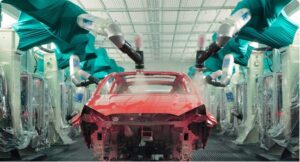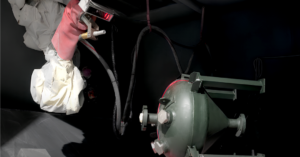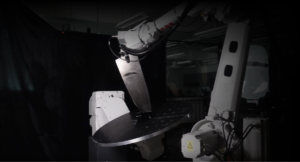table of contents
- Heading 1
- Heading 1
- Heading 1
share this
The Maintenance, Repair, and Operations (MRO) process is crucial for ensuring continuous production in an ever-changing dynamic manufacturing environment, where accuracy and efficiency are paramount. MRO encompasses a variety of tasks necessary to maintain industrial facilities’ infrastructure, parts, machinery, and equipment operating at peak efficiency. With advancements in technology, robotics are now taking center stage in MRO approaches. In this article, we will delve into the details of MRO and discuss how robotics is changing the game for MRO vendors.
Understanding MRO in Manufacturing
In manufacturing, maintenance, repair, and operation (MRO) is a complete strategy that aims to maximize uptime and minimize disruptions. It goes beyond simply fixing faulty gear. Modern MRO methods include a strong emphasis on predictive and preventative processes in addition to reactive maintenance, which deals with problems as they occur. By implementing condition monitoring systems and predictive analytics, manufacturers can avoid costly downtime, schedule maintenance proactively, and predict equipment problems before they happen.
MRO specifically refers to service providers catering to end clients, such as aerospace companies. These specialized vendors focus on maintaining and repairing a wide array of components and equipment, including vital parts of aircraft, industrial machinery, and beyond.
The Vital Components and Processes of MRO
MRO vendors play a crucial role in ensuring the smooth operation of manufacturing facilities by providing a range of services tailored to their clients’ needs. These services encompass tasks like welding, sandblasting, deburring, and other specialized operations required to maintain and repair industrial components and equipment. With a focus on high-mix, low-volume (HMLV) situations, MRO vendors must adapt to the diverse needs of their clients, addressing a multitude of components from different end clients with precision and efficiency.The process for Maintenance, Repair, and Overhaul (MRO) of metal fabricated parts typically involves several key steps to ensure that each part is restored to optimal functionality and performance. Here’s a typical workflow:
- Inspection and Assessment: The first step in the MRO process involves a thorough inspection of the metal parts to assess their condition. This includes visual checks, dimensional measurements, and sometimes more advanced methods like ultrasonic testing or magnetic particle inspection to detect cracks, wear, or other defects.
- Disassembly: If necessary, parts are disassembled to facilitate detailed inspection, cleaning, and repair. This step is critical for complex assemblies where individual components may need separate attention.
- Cleaning: Before any repairs can be made, parts need to be cleaned to remove dirt, grease, and other contaminants. Methods such as solvent cleaning, sandblasting, or ultrasonic cleaning may be used depending on the type of contamination and the metal involved.
- Welding and Fabrication: Damaged components may require welding to fill in cracks or to add material where excessive wear has occurred. In some cases, entirely new parts may be fabricated if the original ones are beyond repair.
- Machining and Grinding: After welding, parts may need to be machined or ground to restore their precise dimensions and surface finish. This ensures that they fit and function as intended when reassembled.
- Heat Treatment: Post-weld heat treatment might be necessary to relieve stresses induced by welding and to restore the mechanical properties of the metal.
- Surface Preparation and Coating: To protect against corrosion and wear, parts are often coated. This can include processes like powder coating, painting, or plating. Surface preparation such as sandblasting or chemical etching is crucial to ensure good adhesion of the coating.
- Reassembly and Testing: Once the parts have been repaired and treated, they are reassembled. The reassembled units are then tested to ensure they meet operational standards. Testing could involve pressure tests, leak tests, or operational tests.
- Calibration: Depending on the function of the metal parts, calibration may be necessary to ensure they operate within the required specifications.
- Quality Control: Throughout the MRO process, quality control checks are important to ensure each stage meets the standards required. Final inspections confirm that the parts are restored to their original or even better condition.
- Documentation: Proper documentation of the processes and parts replaced or repaired is crucial for tracking purposes and future maintenance schedules.
Importance of MRO in Manufacturing
It is impossible to overstate the importance of MRO in manufacturing because component and equipment failure can have far-reaching effects. Unplanned downtime can cause supply chain disruptions, delivery delays, and a decline in customer confidence in addition to the immediate financial losses caused by stopping operations. Furthermore, component and equipment failures in safety-critical industries like aerospace and oil and gas can put people and the environment at serious risk.
For end clients, particularly in safety-critical industries like aerospace, the reliability and effectiveness of MRO services are paramount. Downtime resulting from component and equipment failures can have severe consequences, disrupting operations and jeopardizing safety. MRO vendors play a critical role in minimizing downtime and ensuring the continued operation of essential components and equipment.
Leveraging Robotics in MRO
The integration of robotics into MRO processes represents a significant advancement for MRO vendors, enabling them to enhance their efficiency and effectiveness. Robots offer unparalleled precision and flexibility, making them ideal for performing a variety of maintenance tasks, from welding and machining to surface treatment and beyond. By incorporating robotics into their operations, MRO vendors can streamline processes, reduce turnaround times, and improve the quality of their services. Additionally, robotics allows MRO vendors to handle a wider range of components and adapt to changing client needs with ease.
The Shift Towards Automated Solutions
Growing manufacturing demands for automation and digitalization are driving the use of robotics in MRO. Manufacturers are looking for ways to increase reduce downtime, and maximize efficiency in light of the development of Industry 4.0 technologies. Robots provide an economical way to automate labor-intensive and repetitive operations, freeing up human operators to work on higher-value projects.
With the growing demands of automation and digitalization, MRO vendors are increasingly turning to robotics to meet the demands of their clients. Automation allows MRO vendors to optimize their operations, increase overall equipment effectiveness (OEE), and reduce costs, ultimately enhancing their competitiveness in the market.
Augmentus: Empowering Manufacturing Excellence
Augmentus is at the spearhead of the robotics revolution, enabling manufacturers to unlock their full potential for automation in MRO processes. Our platform allows users to plan, deploy, and control robotic machines without the need for specialized programming skills. As Augmentus, manufacturers can automate a wide repertoire of MRO procedures, such as basic inspections to advanced welding and machining operations. Augmentus with its democratization of robotics programming helps manufacturers to decrease downtime, improve quality of production, and achieve new operational efficiency.
Conclusion
MRO is vital for industrial operations because it guarantees product quality, operational effectiveness, and equipment dependability. Manufacturers can transform their MRO processes and boost efficiency, creativity, and competitiveness by integrating robotics and automation. With Augmentus at the forefront, MRO in manufacturing has a bright future full of growth prospects and previously unheard-of breakthroughs. The future of manufacturing will be shaped by the incorporation of robotics into MRO processes, opening the door to a new era of excellence, sustainability, and efficiency. Stay tuned for more MRO-related content in the coming weeks as we dive deeper into the latest trends and innovations in the industry.




